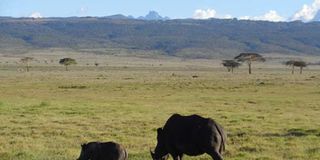The intoxicating landscapes of Lewa

A southern white rhino - mother and calf in Lewa with Batian on Mt Kenya in the backdrop. PHOTO | RUPI MANGAT -
What you need to know:
- The landscape is stunning driving past the lush swamp with ducks and geese in it. The sitatunga haven’t fared well at Lewa after a herd was brought here. The shy antelope with splayed hooves – an adaptation so they don’t sink in the wet earth – got eaten by lions.
- Past the rhino and the enormous herd of buffaloes, the road leads up a hill with another rare animal on the list – the Grevy’s zebra with its thin stripes and rounded ears. It is bigger and more handsome than the common zebra.
- Back at Lewa, it is a sultry day. Samburu’s iconic mountains straddle the horizon – Ololokwe the bread-shaped mountain with its bare cliff face and the Mathews Range. A full moon begins to emerge.
From the high slopes of Mt Kenya, the northern rangelands fill the horizon with peaks and plains. Driving over the underpass on the main road before turning in to Lewa and Isiolo, elephants walk between the low arid plains of the north and the high slopes of Mt Kenya.
Settling in at Ngiri House at Lewa Conservancy, a herd of elephants browse by the lush swamp where a flock of grey crowned cranes have made their home. These beautiful birds of the wetlands lay their eggs hidden in lush reeds. Kenya and Uganda are a stronghold for grey crowned cranes but in the last two decades, their numbers have spiralled down by 80 per cent. The cause? The sale of chicks.
Only recently, there was a case of China looking for hundreds to be kept their ‘safari’ parks, gardens and shopping malls — not to mention a growing demand in other Far and Middle East countries.
The landscape is stunning driving past the lush swamp with ducks and geese in it. The sitatunga haven’t fared well at Lewa after a herd was brought here. The shy antelope with splayed hooves – an adaptation so they don’t sink in the wet earth – got eaten by lions.
The sitatunga is an antelope of the swamps. The species was common around the swamps of Lake Victoria but no longer is because wetlands are rapidly being converted to other land use.
Beyond the high mountain ridges, a granite peak peeps out. It’s Batian, Mt Kenya’s tallest peak. It gets bigger as we drive up towards one of the many hills in the conservancy. A rhino – white with a broad mouth – grazes with her calf. This is the southern white rhino – one of the greatest success stories in conservation.
BREAD SHAPED MOUNTAINS
From a handful surviving at the start of the 20th century in South Africa, the numbers are increasing and all due to good management. Today, there are around 17,000 in the wild, making it the rhino species with the highest population in the world.
Unlike the southern white rhino, the northern white rhino, a subspecies from the war-torn regions of South Sudan, are on the brink of extinction with Sudan, the world’s most eligible bachelor in the nearby Ol Pejeta Conservancy looking for a date on Tinder. As the sole male of his kind in the world, has a real task to perform.
Past the rhino and the enormous herd of buffaloes, the road leads up a hill with another rare animal on the list – the Grevy’s zebra that the Samburu of northern Kenya call Loibor kuram meaning ‘white-rumped’ with its thin stripes and rounded ears. Bigger and more handsome than the common zebra, this equid has had a tough time – again with an 80 per cent crash in 40 years. Its population has diminished from 15,000 in the 1970s to an estimated 2,800 today. Their historical range once covered Somalia, Djibouti, Eritrea, Ethiopia and northern Kenya. Now, Lewa and the northern rangelands are their only home.
A few meters from the Grevy’s, a herd of reticulated giraffe browse on tall acacia. With its beautiful copper coat and network of white patterns, this species of the northern lands has had the same issues as the Grevy’s zebra – a crash in numbers by more than 80 per cent — from about 30,000 – a decade ago to fewer than 5,000 today. Their stronghold is north-eastern Kenya and some isolated populations in Somalia.
For both these species, as well as the rhino, the big cats and raptors, the community conservancies in the northern rangelands are a stronghold.
Back at Lewa, it is a sultry day. Samburu’s iconic mountains straddle the horizon – Ololokwe the bread-shaped mountain with its bare cliff face and the Mathews Range. A full moon begins to emerge.
The spotlight falls on a feline. To everyone’s surprise, it is a cheetah cast in moonlight. A few feet from it is another – crouched in the grass.
“These are two brothers, Wallace and Gromit,” says Wanjiku Kinuthia of Lewa. “They hunt together.
“It’s a strategy – one is the spotter, the other the stalker.”
It’s another thing we’re learning about cheetahs – that they are not completely day-time hunters but very adaptable. Indeed, the Tuareg of North Africa call the cheetah ‘those who move slowly’.
*****
IF YOU GO
Lewa has beautiful lodges and camps. Visit their website, www.lewa.org.
The Safaricom Marathon is run at Lewa every year to raise funds for community conservancies under the umbrella of the Northern Rangelands Trust – it’s on June 21st.
A comfortable five-hour drive north from Nairobi, Lewa is an ideal stopover as you venture further north.




